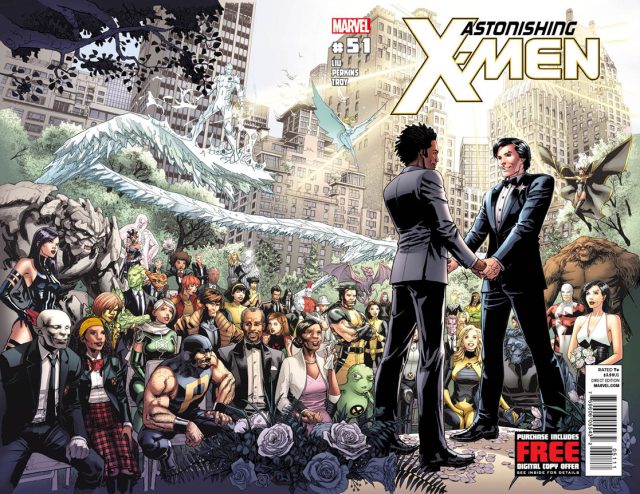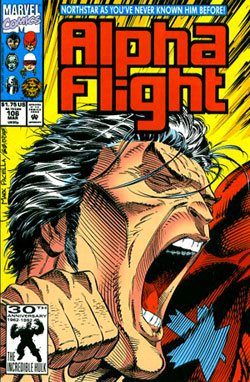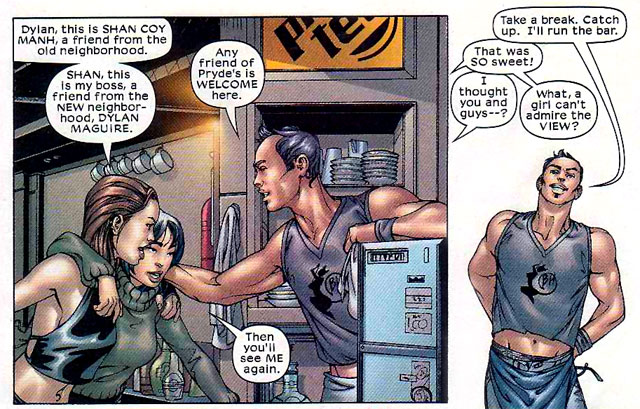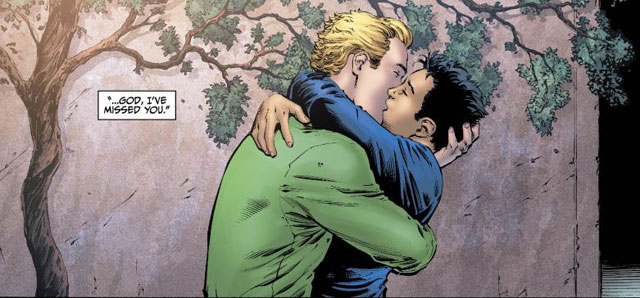
The big comic publishers have a long history of whipping up gimmicky storylines in bids for attention, news coverage, and a corresponding boost in sales ("Superman, is he really dead?"). Marrying a popular couple is a good one; see 1987's marriage between Peter Parker (better known as Spider-Man) and Mary Jane. Over on the DC side nearly a decade later, there was Superman (alive and well!) and Lois Lane dropping the enduring-yet-bizarre love triangle with alter ego Clark Kent and finally tying the knot. These things are never destined to last, of course—witness the somewhat desperate backtracking on Marvel's part to erase Spider-Man's marriage.

This storyline appeared a year before Don't Ask, Don't Tell—the United States policy on gay men and women serving in the military—a particularly relevant piece of real world legislation when it comes to talking about someone who isn't straight putting their life on the line to save people, be they fictional or otherwise. At this time there was no Will & Grace putting gay characters into the mainstream and Ellen DeGeneres hadn't made television history by coming out (in character) in an airport. Comics like Frank Miller's Batman: Year One or Neil Gaiman's The Sandman were slowly breaking down the popular perception of comic books as purely a children's medium, but the notion of a gay hero was still one that generated plenty of ink and controversy. (That's right, ink—this was 1992.)
The early '90s were also the peak of ACT UP (AIDS Coalition to Unleash Power) generating its own headlines. ACT UP activists had tried to hijack the set of the CBS Evening News the year before. The storyline of Alpha Flight #106 revolved around a baby dying of AIDS, and it felt relevant that a superhero would hold a press conference to discuss his sexuality.
It was likely no coincidence that the character Marvel chose to come out was a mutant. Much has been made of the parallels between the struggle for gay civil rights in the real world and the fictional portrayals of mutants fighting for equality and stepping out of their own closet. Themes of distrust and fear of the other are familiar—the neighbor who might look like you but inside is somehow different, people who feel like outsiders inside of a society that at best isn't always welcoming and at worst reacts with unveiled hatred and violence. Media event or not, Marvel was directly speaking to that connection, and it was a somewhat risky move on its part; the public might not have been ready for it.
To Marvel's credit, it stuck with it. Northstar wasn't destined to be the solo gay mutant, though less was made of more minor players like the New Mutants' Karma being revealed as a lesbian. Rather than being a storyline driver it was simply part of the normal fabric of the fictional world.

Fast forward twenty years, and Marvel decides to pull two tricks out of the old playbook. In May 2012 it announced that Northstar was going to marry his boyfriend Kyle. They live in the state of New York, where gay marriage is legal in both the real and comic book worlds, so why not? The story was broken on "The View" and picked up a predictable amount of press. It wasn't the same, though. Rather than staking out a controversial stance ahead of the curve of popular opinion and riding the waves of its own making, Marvel found itself instead playing catch-up to the headlines of the day. Don't Ask, Don't Tell has been repealed. The media is full of openly gay characters. Support for gay marriage in the United States has passed the 50% mark. The president, gearing up for a tough election fight, felt that the political calculus was safe enough to throw his support behind gay marriage.
Nevertheless, the grab for headlines was on, and DC, not content to watch Marvel from the sidelines, announced its own gay hero on June 1st, and this time it was not a minor player from a second-string team like Alpha Flight, but rather Green Lantern himself (albeit from its alternate EARTH 2 universe). Green Lantern is still a household name. People who couldn't tell you who Northstar is for a million dollars would happily take that cash if the question was about that guy with the green power ring. That said, this is still second-string Green Lantern, alternate universe Green Lantern, and it feels a bit like a cautious play, as if DC doesn't want to gamble with the identity of the "real thing".

Cynics might ask, are DC and Marvel truly championing civil rights and equality, or is this purely a grab for headlines and comics sales? Perhaps society has come to the point where the answer can be both. Gay marriage is still a political hot potato and a controversial topic in the ballot booth, but it's mainstream enough that you can reliably bank on it as part of your marketing strategy. Witness JC Penny celebrating the strength of gay families in the face of a threatened boycott. When giant corporations who can turn a movie into a billion dollars in less than three weeks are in the mix, everything is calculated, yes, but it's almost a sign that you've made it when you're even a line on the spreadsheet.
We'd be remiss not to point out that indie comics have tackled ideas like this for decades, and have long been more comfortable addressing issues like sexuality head on. This isn't really a commentary on sexuality in the comic medium itself, but more about the big dogs who play it safe.
It's also important to note that no matter how calculated or cynical these ploys might be, there are gay comic readers out there who have never seen themselves reflected in the main heroes of Marvel or DC. Even if slightly hedged, a major character like Green Lantern coming out is a chance to catch a glimpse in that mirror, something straight readers have been unconsciously able to take for granted since they first opened a mainstream comic book.
Is it a sign that mainstream comic books have truly grown up? Maybe. We're still talking about men and women with superpowers flying around in spandex. There's always going to be a childish heart there, no matter how much grit and sexuality you try to pile on top of it. It is more likely that a natural progression is once again occurring, where what was controversial is mainstreaming and simply being reflected just a little ahead of its time. That's something the best fantasy writing accomplishes. As celebrated science fiction writer William Gibson once noted, "The future is already here—it's just not evenly distributed."
Reader Comments (379)
View comments on forumLoading comments...